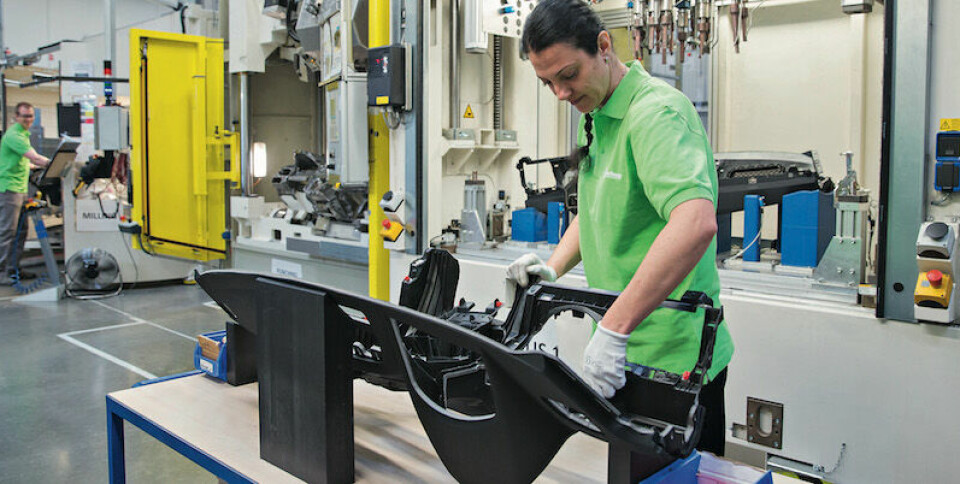Operation and cooperation
The working relationship between design and manufacturing departments can optimise processes, reduce costs and make the most of the best ideas

Genuine leather, synthetic leather, thermoplastic polyolefins and slush skins have become standard surface materials in cockpit production. These various surface concepts usually call for multiple-stage production processes, requiring specific tools. Now, Yanfeng Automotive Interiors has prepared a new production process for making leather-wrapped instrument panels, genuine or synthetic, that can optimise production of more than one surface option to a single line.
The company’s executive director for process innovation Oliver Becker says the idea was born when work began on a new order programme for an instrument panel with two different surfaces: “One was a thermoplastic polyolefin, grained in a tool then applied with a process we call ‘foam and place’, applying the polyurethane foam behind the foil. With the foam acting as a glue, we combine the surface material with the carry material. The result was a good looking but a fairly inexpensive surface material for an instrument panel.”
[sam_ad id=17 codes='true']
The other material to be serviced, Becker adds, was an artificial leather from a roll then cut and sewn to cover the instrument panel. So, two different lines and two toolsets were required. The initial request from the customer was that the synthetic leather take-up rate would only be 10%, with the vast majority of orders opting for the thermoplastic polyolefin surface material.
“It turned out to be vice-versa,” Becker says. “Through the first year, the customers that ordered the vehicle selected for 100% synthetic leather option. Hardly anyone wanted the thermoplastic polyolefin, so there was entire manufacturing line mostly standing idle.” Consequently, the unpredictable order mix also meant that the other line, processing the thermoplastic polyolefin material, had to keep up with much higher demand – 100% instead of the predicted 10% take-up.
“This is why we had to come up with a manufacturing solution that would allow us to run three different surfaces over one line. We came up with the idea of applying foam and place, not just with the PVC but with artificial leather or even real leather.“
Leather mouldingAnother innovation at Yanfeng Automotive Interiors, developing a new leather component production process, demonstrates well the company’s culture of encouraging close ties between design, engineering and production.
This process involves inserting pre-cut, uncoated leather into a back-moulding tool with a thermoplastic injection mould behind it. The high internal mould pressure means the leather can be shaped three-dimensionally and embossed with a pattern. Once back-moulded, the component is lacquered and the result is a hard, leather-covered surface with extraordinary reliefs.
“Injection moulding behind a certain cover stock has been around for many years. So our idea was to try to mould behind other surface materials – ceramic, wood and leather,” Becker explains. The usual routine in leather-wrapping a certain component is to use the force of a press for the covering process. The force is usually low, it can even be done by hand. With this new process, the mould offers much higher forces, 200 bar inside the cavity, and according to Becker, the process allows a freedom in design that Yanfeng Automotive Interiors had not seen previously.
“We talked to the designers and asked, look what we have, is this valuable? And a designer never complains about increase of freedom in design,” he adds.
The next generation of materialsBecker explains that his department is responsible for exploring new materials and production processes but also listens carefully to the design department, which challenges his team to find the next generation of materials. It’s a dialogue, with ideas and challenges flowing both ways.
“We work together – there is no ‘chicken and egg’ discussion. If we come up with a new surface material, it might have different design limitations just by the nature of the material. Looking at a past instance, if we leather-wrap an instrument panel, we need a different design than if it was a PVC slush instrument panel, which gives you the highest freedom of design.”
Dominique Taffin, senior manager for industrial design at Yanfeng Automotive Interiors, is glad of the close ties, seeing little to differentiate between engineering and design. “They are on the same track,” he states. “As Oliver mentioned, there is always a balance between who challenges whom. Obviously, in the development of a product, sharing research is the first step into what could happen. Technology and processes condition how well our products turn out.”
A creative and innovative engineer is the designer’s best friend, Taffin adds. If they both have the same goal, getting the product on the market, perceived well by the user, that leads to progress.

"We talk to the designers and ask, ‘is this valuable?’ A designer never complains about an increase of freedom" - Oliver Becker, YFAI
Looking ahead to how the design and production of interiors are set to evolve, both men agree that by no means would any OEM accept any kind of quality deviation, regardless of the continuing challenges suppliers face on cost, time, volume, sustainability and flexibility.As new-generation vehicles become quieter – EVs for example will have a significantly different sound profile – and as engine noise declines, robust standards will address “buzz-squeak-rattle”. Meanwhile, lightweighting will bring a new form language and a alternative perception of quality.
“It might be possible that the new generation of users will have a different approach on quality perception and the user experience,” says Taffin. “I can expect the new generation of consumers is going to have a different way to look at the interior. This is a typical example of how we work together in order to understand how the product can correspond to OEMs’ specifications and consumers’ demands.”Becker reiterates that quality expectation will remain high, but he foresees the OEMs could shift the value distribution of the interior itself. “New interior surfaces and will be quite expensive,” he admits.
“I don’t believe the OEMs will put additional money into the interior, so they will have to conduct VA/VE procedures on some other components of the automotive interior. For example, door panels, especially lower parts, may not be covered with a textile but become injection-moulded to free up budget for the more expensive components. But I believe that the quality expectation will remain very high.”
The interior of the futureSet up in 2015, Yanfeng Automotive Interiors is a joint venture between the established names of Yanfeng Automotive Trim Systems and automotive seating specialist Adient. Headquartered in Shanghai but with around 100 manufacturing plants and technical centres, it produces instrument panels and cockpit systems, door panels, floor and overhead consoles solely for automotive.

"Sharing research is the first step into what could happen. Technology and process condition how our products turn out" - Dominique Taffin, YFAI
It operates working groups that invite comment from OEM customers and end users to explore the vehicle interior of the future against the megatrends such as EVs, autonomous vehicles and shared mobility. In the case of latter, the materials used will need to be durable, easy to clean, simple to design and most likely the interior will focus on few elements.
In recent years, additional vehicle segments have emerged and the distinction between them has softened. Furthermore, volume targets are now spread across these broader ranges and new vehicles are developed and introduced with greater regularity.
From a manufacturing point of view, Becker sees the biggest challenge comes from establishing production processes that can master the flexible demands, in volume and model mix.
“We have to design manufacturing lines that are capable of dealing with different kinds of volume, different take-up rates, changing demands, and responding when a model hasn’t proved successful. Or maybe a vehicle is much more successful than originally planned. From a manufacturing point of view, it remains a tough challenge.”


